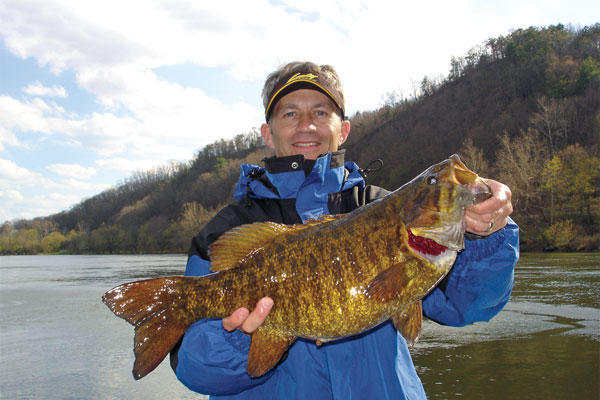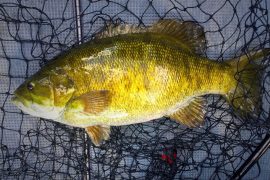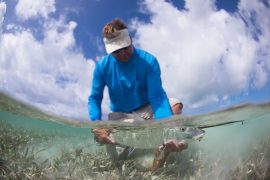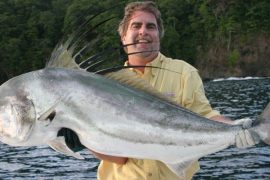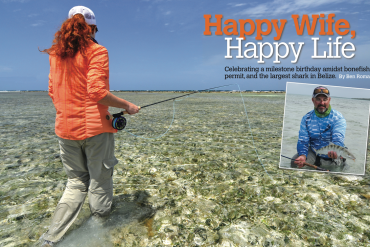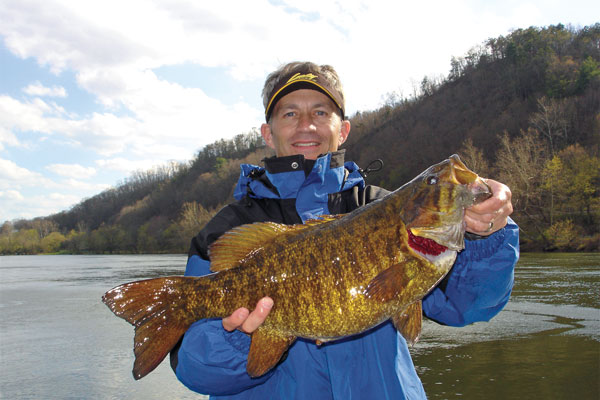
Yachtsmen recognize the term “Roaring Forties” as consistently strong westerly winds in the southern hemisphere, generally between the latitude of 40 and 50 degrees. But dedicated river smallmouth anglers identify the Roaring 40s as the exciting early-spring bite that occurs as bronzebacks stir from their winter’s respite and begin feeding heavily to bulk up for the spawn, which may be more than a month away. This period roughly coincides with water temperature climbing from 40°F to 50°F.
The Roaring 40s is my favorite time of year. First, it’s the year’s initial encounter with battling bronzebacks. I also find it the best time of the year on a river to catch numbers of big smallmouth bass.
To provide insights into this bite on different rivers, I enlisted three top smallmouth bass guides on eastern rivers to provide details about their waterways. Britt Stoudenmire has been guiding on Virginia’s New River for 14 years, Mike Breeding on Pennsylvania’s Susquehanna River for 15 years, and Jeff Knapp on the free-flowing section of the Allegheny for 12 years.
During the coldest times of year, river smallmouths are rather inactive, hanging out in slow-current winter holes. Precise location and depth vary, based on characteristics of each river. But in all locations, as winter wanes and temperature begins to climb, smallmouths start moving and feeding.
What triggers the earliest spring bite?
Stoudenmire: Anglers often only look at water temperature as the trigger to this early-spring bite, but I believe that photoperiod (amount of sunlight per day) is the major factor. I don’t set a limit on the lower end of temperature, but for the bite to take off I like to see a slow consistent rise toward 50°F, often in early March.. The mid- to upper-40°F range is optimal. Once water temperatures surpass 50°F, bass can become scattered and picky.
Breeding: I go with water temperature as the #1 factor for the initial spring bite. I refer to the period of river temperature rising from the high-30°F range into the low 40s as prime time. That’s when bass get their metabolism going and want to eat. At this point, every bass in the river is on the same page. As you approach 50°F degrees and the Prespawn Period, photoperiod and flow become more important.
Knapp: The first warming trend of spring or late winter wakes up middle-Allegheny smallmouths. By warming trend I mean three to four consecutive days of unseasonably mild weather once the river is free of ice, with lots of sun and air temperatures in the 60s or above. River flow also enters the picture—high dirty water delays the bite. I’ve seen the season’s initial smallie bite happen as early as February and as late as April, but typically it’s around mid-March.
What locations do you find smallmouths feeding as they transition from wintering locations to spawning grounds?
Stoudenmire: It’s a journey from slower, deeper habitat to shallower habitat. Often you can recognize transitional locations by the visible separation of current, sometimes called current seams. Over the years, however, I’ve found that the most consistent locations for big smallmouths are hard to recognize during high spring flows. The best sites are uncovered during low-water months when objects that create a hidden high-water break can be seen above or below the surface. Mark them and return in spring.
Breeding: With snowmelt and spring runoff raising river levels, bass leave ledge pools and head toward the bank. This movement is accompanied by increased feeding and competition for forage among bass. Below 40°F, bass focus their minimal feeding on baitfish. But once the river reaches the mid-40°F range, they concentrate more on crayfish. We typically have high flows that flood shoreline areas, flooding bank brush and small trees. Smallmouths often move into this cover to feed.
Knapp: As the water warms and smallmouths become more active, they move shallower, following a food chain that also is becoming more active. They may move toward the bank of a pool or hole, or perhaps onto rock flats just upriver or downriver of the wintering hole. It’s typical…

